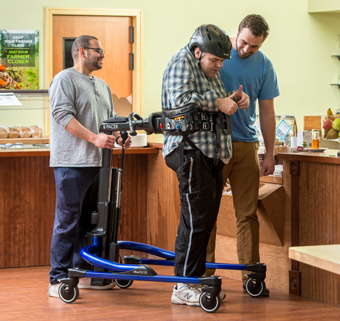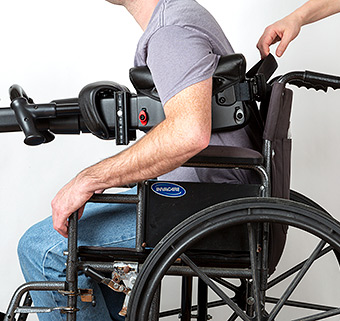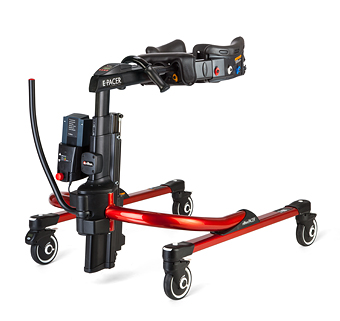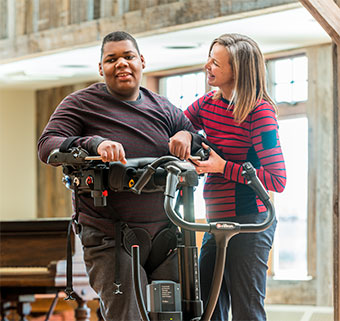Sample LMN for the Rifton TRAM: School-Based Therapy with Adolescents
| August 2012Components of a Letter of Medical Necessity for use in school-based therapy of an adolescent.
Note: Every reasonable effort has been made to verify the accuracy of the information. However, the sample letter of medical necessity is not intended to provide specific guidance on how to apply for funding for any product or service. Health care providers should make the ultimate determination as to when to use a specific product based on clinical appropriateness for a particular patient and applications to any funding source must accurately reflect the facts unique to individual applications. Third party payment is affected by numerous factors and Rifton cannot guarantee the success in obtaining insurance or third party payments of any kind.
Briefly introduce who you are, what you want, and beneficiary’s name:
As John Doe’s physical therapist, I am requesting funding authorization for a Rifton TRAM.
Establish your credentials, experience in the field, and relationship to beneficiary:
I have worked in the school system as a physical therapist since I graduated in _____ providing services including recommendation and fitting of adaptive equipment for children and young adults with disabilities. Five years ago I became certified as an APTA Pediatric Specialist. Since I am also a certified Rehabilitation Technology Supplier, I provide staff seminars on utilizing assistive technology in the school setting. I have been John’s physical therapist for the last two years seeing him on a bi-weekly basis.
Explain beneficiary’s condition including diagnosis, or nature of injury:
John Doe has a diagnosis of quadriplegic cerebral palsy. His quadriplegia is accompanied by spasticity of the upper and lower extremities with poor controlled movements and muscular weakness in the trunk, arms, and legs. He has flexion contractures in his right hip and knee and a small pressure ulcer under the right buttock. Because he cannot support himself in standing, his primary means of mobility is a custom powered wheelchair. Lack of independent standing requires John’s toileting to be done on a mat table. As John is a growing teenager, performing sit-to-stand pivot transfers to reach the mat table or to get into bed require the assistance of two people. John can bear about 25% of his weight to help with these transfers. Except for these transfers, John spends most of his day in his wheelchair.
Describe beneficiary’s current functional level noting their limitations without the appropriate adaptive equipment.
With continued dependence on his wheelchair, John is progressively losing what little functional abilities he does have, and sustained sitting puts him at an increased risk for pressure ulcers, contractures, and osteoporosis. Currently he has the capacity to bear 25% of his own weight, but has no support for continued practice of this skill or any ambulation skills. It has been shown that even the most significantly involved person, given enough repetitions, can learn new skills, but there must be many opportunities to practice them. Without the appropriate support and equipment John will regress, becoming fully dependent for all transfers and functional mobility. As he grows in height and weight, this factor becomes significantly more important to his caregivers.
Additionally mat table toileting for a teenager is humiliating and time-consuming. John becomes withdrawn and silent when removed from the classroom for hygiene care and often refuses to participate in these transfers. He needs a solution to toileting that will maintain his dignity, simplify the process, and encourage him to participate in his self-care.
State the type of equipment and accessories being requested:
I am requesting a Rifton TRAM for John with a built-in scale, forearm supports, pelvic support, and directional lock. The Rifton TRAM will support even the most significantly involved individual in a seat-to-seat transfer, sit-to-stand transfer, or upright position while allowing for lower extremity movement that is comfortable and therapeutic in many ways. Being upright and mobile also improves respiration, digestion, circulation, and bowel/bladder function, and provides the opportunity for gravity-assisted stretching, self-initiated joint ROM, and bone development.
Describe why the device is medically necessary. Show how the requested equipment will result in an increase of function and other physical benefits:
The Rifton TRAM is medically necessary for John because it will give him the much needed support in all his transfers, plus giving opportunities to participate in the transfers and practice standing and gait. These are important functional skills for John to work on and maintain especially as he continues to grow. And because the TRAM has a 350lb weight limit, John will be able to use this device until he graduates from the school system.
1. As John approaches young adulthood, he needs a solution to hygiene care that reflects this change for his own dignity and emotional needs. John’s toileting happens 4-5 times during the day. All his peers toilet in private, while John is wheeled out of his classes and assisted by two attendants for diapering on a mat table. John’s size often makes this task difficult and time-consuming for the caregivers, increasing their risk of injury, and John loses valuable time in class. The Rifton TRAM is medically necessary because its unique transfer option will allow one caregiver to assist John in the bathroom without any strain, with John being toileted in an upright position. John will be able to bear his weight and assist with the transfer and have the opportunity to void in a toilet. Transfers with the TRAM are quick and easy and will decrease the time spent away from classes.
2. In his wheelchair, John depends on the arm rests to help stabilize his trunk and head, supporting his shoulder girdle so he can keep his body aligned and his head upright. With the Rifton TRAM it is the same. He will require the forearm supports to help stabilize his trunk and head during transfers, standing, and gait. The forearm supports will also help control the spastic movements of his upper extremities allowing him to fully concentrate on participating in his mobility tasks.
3. Since John is receiving services under the Individuals with Disabilities Education Act he needs a reliable measurement to show that his weight bearing and self-care goals on the IEP are being met. The scale on the Rifton TRAM not only records John’s weight, but can be quickly programmed to show how much weight John is taking through his lower extremities. This will give his caregivers a concrete way to show progress in his interventions for improved strength and weight bearing ability.
4. When supported in gait training equipment, which he has now outgrown, John has shown the capability to take a few steps. He would need the support of the pelvic support on the Rifton TRAM for this purpose. The pelvic support can be adjusted initially to support the full weight of the user with the option of progressively diminishing this support as the user improves, allowing them to become more independent in weight bearing and gait.
5. Since the spasticity in John’s upper and lower extremities will cause his gait to be jerky and not well controlled, he will need a directional lock on the Rifton TRAM to guide the movement and keep the TRAM in a straight line course, avoiding collisions with the walls of the hall or with other pedestrians. The directional lock will allow for easier steering and control of the device during tranfers and ambulation.
Can include Itemization of the Rifton TRAM here (see addendum below)
Describe other equipment previously trialed and why it didn’t work.
I have considered alternatives, but determined this equipment could not adequately meet John’s needs. As mentioned above, John has trialed gait training equipment which worked well for a time until he outgrew it and the transfers into this piece of equipment became too dangerous. The two caregivers performing the transfers could not safely hold John in an upright position long enough for him to be secured in the device putting John at risk for falls and increasing the caregivers’ risk for injury. The same is true with a stander we trialed. Additionally, these “single-purpose” pieces of equipment did not completely fill John’s needs for transfer, gait, and toileting simultaneously, as achieved by the TRAM.
The Rifton TRAM combines gait training, standing, and toileting into one device with the added benefit of safe and secure transfers into all positions. For John, this has been the solution to improving his functional skills and participation in self-care as was evident during its trialing period.
The TRAM is smaller and easier to use than a standard or power Hoyer® lift. Several attempts to try a Hoyer® lift with John for tranfers to the mat table proved to be cumbersome, time-consuming, and presented with some safety concerns unless two or more staff were present. Particularly difficult is the proper positioning of the sling underneath John.
The TRAM is user friendly and staff persons who typically would need repetition of instructions, have demonstrated competent understanding in use of the TRAM with minimal verbal cues after only one demonstration of the product.
Summarize cost benefits. Explain that the recommended device is the least costly alternative.
In my opinion, The Rifton TRAM is the least costly alternative:
- Its unique transfer and mobility options allow for multiple uses with one piece of equipment as opposed to the purchase of multiple pieces of equipment for one user. Selecting the TRAM will replace the necessity of purchasing three separate products for the same functions. (Estimated costs: Lift device $3000-$7000, Stander $3000-$6000, Gait Trainer $3000-$6000)
- The use of the TRAM requires one caregiver to assist with all transfers and mobility functions and caregiver injury is reduced as there is zero-lifting on the part of the caregiver for all transfers with the TRAM.
- Expensive surgeries and increased medical intervention will be avoided as the Rifton TRAM will assist in maintaining functional skills and overall health of the user.
- To my knowledge there is no other similar device available on the market.
Make the person real including goals:
John’s goals for this semester are to bear 30% of his weight during transfers and initiate steps for ambulation. He cannot achieve these goals while dependent on a wheelchair. His functional mobility and participation in hygiene care become very important to him especially as he looks towards the future when he will no longer be eligible for school therapy services and depend on maintaining his skills in a group home or day rehabilitation center.
Concluding paragraph restating the main points of the report:
Therefore, it is my opinion, according to the evaluation and trialing of equipment for John, that the most effective and least costly option would be the Rifton TRAM for safe and effective transfers, gait practice, and hygiene care.
Don’t forget to include pictures of the Rifton TRAM


Itemization of the Rifton TRAM
|
Item |
Description of Medical Necessity |
|
Basic TRAM  |
Allows for safe seat-to-seat transfers, toileting transfers, sit-to-stand transfers, and gait practice. |
|
Scale  |
With the scale, a user’s weight can be measured easily during a routine transfer. It can also be programmed to measure how much weight a person is bearing through their lower extremities while in standing, allowing the caregiver to measure and track weight-bearing capability and progress. |
|
Arm prompts  |
Allow for shoulder/arm positioning to assist weight-bearing, enable forward-lean during transfers and gait, improve strength/endurance of shoulder girdle to assist head control. Selection of forearm supports is based on size: Padded surface area: small: 4½” x 7” large: 5” x 8½”range of adjustment (elbow to |
|
Arm platforms  |
Arm platforms allow for shoulder/arm positioning to assist weight-bearing, enables forward-lean during gait, improves strength/endurance of shoulder girdle to assist head control. |
|
Pelvic Support  |
Provides safety, support, and weight-bearing assist while allowing for movement during sit-to-stand transfers and walking. Selection of the pelvic support is based on thigh size: |
|
Hip Positioner  |
Hip positioner provides safety and support while allowing for movement during walking. Selection of hip positioner is based on size: Length of hip positioner (without pad): small 9”, large 11”. |
|
Directional lock  |
Acts as a wheel guide. Prevents casters from swiveling from side to side, and keeps the device moving in a straight line as user practices ambulation skills. Improves steering of the device and allows user to become more independent. |
|
Additional battery 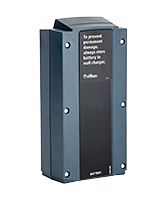 |
Necessary for a heavily used TRAM, allowing one battery to charge while the other one is in use. |
|
Additional thigh straps 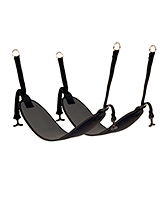 |
Needed to accommodate cleaning schedules of a heavily used TRAM allowing one set of leg straps to be cleaned while the other is in use. |
|
Switch Pole  |
The switch pole allows raising and lowering the TRAM by either the client or the caregiver. |
|
Removable back belt  |
Removable back belt provides a clip at both ends for easy removal and sanitation, required when infection control is critical. |
Don’t forget to include pictures of the Rifton TRAM.



